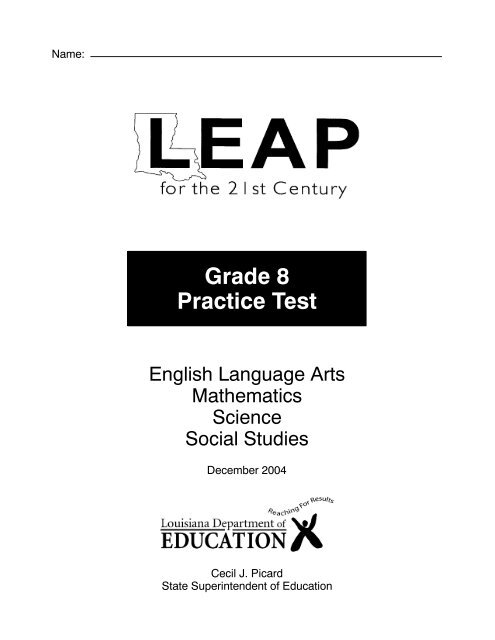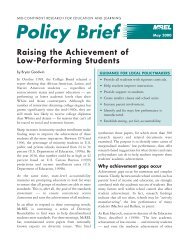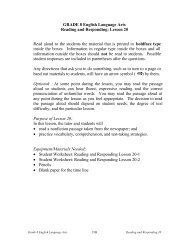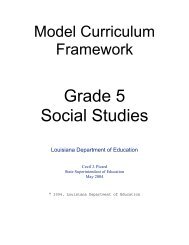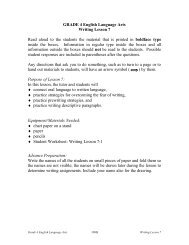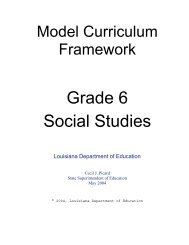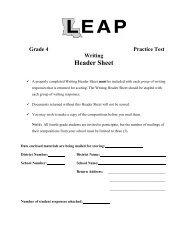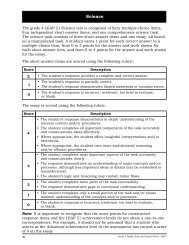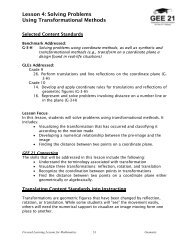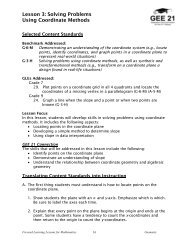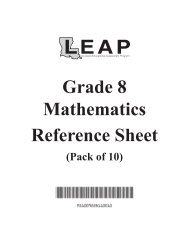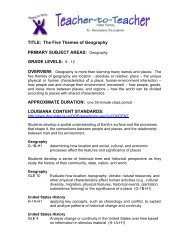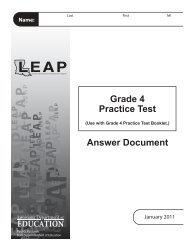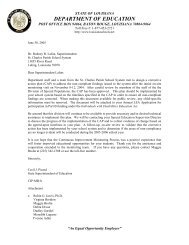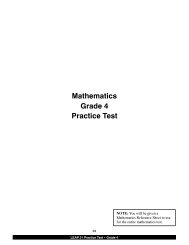Grade 8 Practice Test - Louisiana Department of Education
Grade 8 Practice Test - Louisiana Department of Education
Grade 8 Practice Test - Louisiana Department of Education
Create successful ePaper yourself
Turn your PDF publications into a flip-book with our unique Google optimized e-Paper software.
Name:<br />
<strong>Grade</strong> 8<br />
<strong>Practice</strong> <strong>Test</strong><br />
English Language Arts<br />
Mathematics<br />
Science<br />
Social Studies<br />
December 2004<br />
Cecil J. Picard<br />
State Superintendent <strong>of</strong> <strong>Education</strong>
LOUISIANA STATE BOARD OF ELEMENTARY AND SECONDARY EDUCATION<br />
Ms. Glenny Lee Buquet<br />
President<br />
3rd District<br />
Mr. Walter Lee<br />
Vice President<br />
4th District<br />
Ms. Linda Johnson<br />
Secretary-Treasurer<br />
8th District<br />
Ms. Penny Dastugue<br />
1st District<br />
Ms. Louella Givens<br />
2nd District<br />
Dr. James Stafford<br />
5th District<br />
Ms. Polly Broussard<br />
6th District<br />
Mr. Dale Bayard<br />
7th District<br />
Mr. Edgar Chase<br />
Member-at-Large<br />
Ms. Leslie Jacobs<br />
Member-at-Large<br />
Ms. Mary Washington<br />
Member-at-Large<br />
Ms. Weegie Peabody<br />
Executive Director<br />
Division <strong>of</strong> Student Standards and Assessments<br />
1--877--453--2721<br />
www.louisianaschools.net<br />
The <strong>Louisiana</strong> <strong>Department</strong> <strong>of</strong> <strong>Education</strong> (LDE) does not discriminate on the basis <strong>of</strong> sex in any <strong>of</strong> the education<br />
programs or activities that it operates, including employment and admission related to such programs and activities.<br />
The LDE is required by Title IX <strong>of</strong> the <strong>Education</strong> Amendments <strong>of</strong> 1972 (Title IX) and its implementing regulations not<br />
to engage in such discrimination. LDE’s Title IX Coord. is J. J. Guilbeau, Deputy Undersecretary, LDE, Exec. Office <strong>of</strong><br />
the Supt.; PO Box 94064, Baton Rouge, LA 70804--9064; 877--453--2721 or customerservice@la.gov. All inquiries<br />
pertaining to LDE’s policy prohibiting discrimination based on sex or to the requirements <strong>of</strong> Title IX and its<br />
implementing regulations can be directed to J. J. Guilbeau or to the USDE, Asst. Sec. for Civil Rights.<br />
This public document was published at a cost <strong>of</strong> $38,225. Seventy-two thousand (72,000) copies <strong>of</strong> this document were<br />
printed in this first printing at a cost <strong>of</strong> $38,225. The total cost for the printing <strong>of</strong> this document, including reprints, was<br />
$38,225. This document was published by the <strong>Louisiana</strong> <strong>Department</strong> <strong>of</strong> <strong>Education</strong>, Office <strong>of</strong> Student and School<br />
Performance, Division <strong>of</strong> Student Standards and Assessments, P.O. Box 94064, Baton Rouge, <strong>Louisiana</strong> 70804--9064,<br />
by Data Recognition Corporation, 13490 Bass Lake Road, Maple Grove, Minnesota 55311. This material was printed in<br />
accordance with the standards for printing by State Agencies established pursuant to R.S. 43:31.<br />
2<br />
LEAP 21 <strong>Practice</strong> <strong>Test</strong> - <strong>Grade</strong> 8
Introduction to Students<br />
This is a <strong>Practice</strong> <strong>Test</strong> to show you what each part, or session, <strong>of</strong> the<br />
real LEAP 21 (<strong>Louisiana</strong> <strong>Education</strong>al Assessment Program for the 21st<br />
Century) is like. The <strong>Practice</strong> <strong>Test</strong> looks similar to the real test.<br />
You may use the <strong>Practice</strong> <strong>Test</strong> at home or at school to become familiar<br />
with what the real test is like. This can help you feel more relaxed when<br />
you take the real test.<br />
On the real test, you will write your answers in an answer document,<br />
and some test sessions are in the answer document. However, on this<br />
<strong>Practice</strong> <strong>Test</strong> all <strong>of</strong> the sessions are in the test booklet, where you<br />
may write your answers.<br />
Some sessions <strong>of</strong> the <strong>Practice</strong> <strong>Test</strong> are shorter than those on the real<br />
test. After each session, look for the NOTE that tells you the number <strong>of</strong><br />
questions that are on the real test.<br />
In March, you will take the LEAP 21, a test that will measure your skills<br />
in English language arts, mathematics, science, and social studies. The<br />
LEAP 21 will help determine whether you have the skills and<br />
knowledge you need to succeed in the next grade.<br />
Answers to the questions for this <strong>Practice</strong> <strong>Test</strong> are in the back <strong>of</strong> this<br />
booklet.<br />
For more information regarding the test, go to www.louisianaschools.net and<br />
click on “<strong>Test</strong>ing.”<br />
Want to <strong>Practice</strong> More Online<br />
When you use a computer, try signing on to PASS<br />
(<strong>Practice</strong> Assessment/Strengthen Skills) to help you<br />
improve your skills and knowledge. To get started, go to<br />
http://www.louisianapass.org and type in the password tiger.<br />
On PASS, you can solve multiple-choice, short-answer, and essay questions<br />
similar to those on LEAP 21. Plus, you can get help if you answer a question<br />
incorrectly. Your essays are hand-scored, and your score is returned within a<br />
couple <strong>of</strong> days. After you finish a unit <strong>of</strong> questions, you can play a game or go<br />
to a new Internet destination to learn interesting facts and ideas about our<br />
world.<br />
3<br />
LEAP 21 <strong>Practice</strong> <strong>Test</strong> - <strong>Grade</strong> 8
4<br />
LEAP 21 <strong>Practice</strong> <strong>Test</strong> - <strong>Grade</strong> 8
English Language Arts<br />
<strong>Grade</strong> 8<br />
<strong>Practice</strong> <strong>Test</strong><br />
5<br />
LEAP 21 <strong>Practice</strong> <strong>Test</strong> - <strong>Grade</strong> 8
Session 1—Writing<br />
Read the topic in the box below and write a well-organized composition <strong>of</strong> at least<br />
150-200 words. Be sure to follow the suggestions listed under the box.<br />
Writing Topic<br />
1.<br />
The local newspaper is sponsoring a composition contest, and you decide<br />
to enter. In your composition, you should explain your response to the<br />
following:<br />
If you could be granted one wish, what would that wish be<br />
Before you begin to write, think about one wish you would like to come true.<br />
It can be a wish for yourself or someone else. What is that wish Why<br />
would you like to have that wish granted<br />
Now write a multiparagraph composition for the newspaper<br />
explaining what you would wish for if you were granted one wish.<br />
D<br />
D<br />
Give specific details and explain why you think the way you do so that<br />
your readers will understand what you mean.<br />
Be sure to write clearly and to check your composition for correct<br />
spelling, punctuation, and grammar.<br />
Use page 7 in this test booklet for notes, brainstorming, and/or writing an outline. Write a rough draft<br />
on page 8 <strong>of</strong> this test booklet. Write your final draft on page 9.<br />
NOTE: On the real test, your teacher<br />
will read aloud this page to you. Also,<br />
on this session <strong>of</strong> the test only, you<br />
may use a dictionary and thesaurus,<br />
along with the Writer’s Checklist.<br />
6<br />
LEAP 21 <strong>Practice</strong> <strong>Test</strong> - <strong>Grade</strong> 8<br />
PLEASE GO ON TO THE NEXT PAGE
Use for notes, brainstorming, and/or an outline.<br />
7<br />
LEAP 21 <strong>Practice</strong> <strong>Test</strong> - <strong>Grade</strong> 8<br />
PLEASE GO ON TO THE NEXT PAGE
Rough Draft<br />
8<br />
LEAP 21 <strong>Practice</strong> <strong>Test</strong> - <strong>Grade</strong> 8<br />
PLEASE GO ON TO THE NEXT PAGE
1. Final Draft<br />
NOTE: On the real test, you will have two pages to write<br />
your rough draft and two pages for your final draft, which<br />
you will write in a separate answer document.<br />
9<br />
LEAP 21 <strong>Practice</strong> <strong>Test</strong> - <strong>Grade</strong> 8
Session 2—Reading and Responding<br />
In this session <strong>of</strong> the test, you will read two passages. Then you will answer questions<br />
about what you read. This session <strong>of</strong> the test contains both multiple-choice and<br />
short-answer questions. Answer these questions on the lines provided.<br />
Do you remember building with Legos or Tinker Toys Building your own bridges can<br />
help you understand how natural rock bridges work. The following directions tell you<br />
how to build a bridge with books and chairs. Read to find out how and why this can be<br />
done. Then answer questions 2 through 6.<br />
Rock Bridge<br />
Purpose:<br />
Materials:<br />
To demonstrate how natural bridges stand.<br />
books<br />
2 flat chairs the same height<br />
Procedure:<br />
S Move the chairs about 12 in. (30 cm) apart.<br />
S Lay one book on each chair with the edge <strong>of</strong> the books even with the edges <strong>of</strong> the chairs.<br />
S Stack books on top <strong>of</strong> each other so that each book extends farther over the edge <strong>of</strong> the chair.<br />
S Continue stacking the books until one book overlaps the stack from both chairs to form a bridge.<br />
Results: No part <strong>of</strong> the bottom books overlaps the edge <strong>of</strong> the chair. Each book above the bottom book<br />
extends over the chair’s edge until the top book is totally over the edges <strong>of</strong> the chairs.<br />
Why All objects behave as if their weight is located in one spot called the center <strong>of</strong> gravity. The book<br />
bridge balances because the center <strong>of</strong> gravity <strong>of</strong> each side <strong>of</strong> the bridge is over a chair. In nature, natural<br />
rock bridges are formed by weathering and erosional processes. These bridges balance because the<br />
particles making up the bridge overlap in such a way that they place the center <strong>of</strong> gravity <strong>of</strong> the structure<br />
over the supporting sides.<br />
10<br />
LEAP 21 <strong>Practice</strong> <strong>Test</strong> - <strong>Grade</strong> 8<br />
PLEASE GO ON TO THE NEXT PAGE
For questions 2 through 5, darken the circle beside the correct answer. Mark only one<br />
answer for each question.<br />
2. The form <strong>of</strong> writing in these directions<br />
most resembles<br />
A. a recipe.<br />
B. an advertisement.<br />
C. a book review.<br />
D. a newspaper article.<br />
4. A rock bridge <strong>of</strong> books demonstrates the<br />
way in which<br />
A. bridges are used.<br />
B. people utilize earth science.<br />
C. natural bridges are built.<br />
D. natural bridges stand.<br />
3. What is the main purpose <strong>of</strong> the<br />
illustration in “Rock Bridge”<br />
A. to enhance the reader’s<br />
enjoyment<br />
B. to clarify information in the text<br />
C. to persuade the reader<br />
D. to share a point <strong>of</strong> view different<br />
from the text<br />
5. Building the book bridge makes it easier<br />
to understand<br />
A. center <strong>of</strong> gravity.<br />
B. weathering.<br />
C. erosion.<br />
D. support and distance.<br />
Write your answer to question 6 on the lines provided below.<br />
6. Explain how this passage is different from one that is mainly intended to amuse the reader.<br />
NOTE: On the real test, you will answer two<br />
short-answer questions about a short passage.<br />
11<br />
LEAP 21 <strong>Practice</strong> <strong>Test</strong> - <strong>Grade</strong> 8
This story about unusual creatures and outer space travel has an unexpected ending.<br />
Read the story and answer questions 7 through 11.<br />
Every August twenty-third, the great silver spaceship carrying Pr<strong>of</strong>essor Hugo’s<br />
Interplanetary Zoo settled down for its annual six-hour visit.<br />
Before daybreak crowds would form, long lines <strong>of</strong> children and adults both, waiting with<br />
wonderment to see what strange creatures the Pr<strong>of</strong>essor had brought this year.<br />
In the past they had sometimes been treated to three-legged creatures from Venus, or<br />
snakelike horrors from somewhere more distant. This year, as the great round ship settled slowly<br />
to earth in the huge tri-city parking area, they watched with awe as the sides slowly slid up to<br />
reveal the familiar barred cages.<br />
In them were some wild breed—small, horselike animals that moved with quick, jerking<br />
motions and constantly chattered in a high-pitched tongue. The citizens <strong>of</strong> Earth clustered<br />
around. Soon the good Pr<strong>of</strong>essor himself made an appearance, wearing his rainbow cape and top<br />
hat. “Peoples <strong>of</strong> Earth,” he called into his microphone.<br />
The crowd’s noise died down and he continued. “Peoples <strong>of</strong> Earth, this year you see a real<br />
treat—the little-known horse-spider people <strong>of</strong> Kaan—brought to you across a million miles <strong>of</strong><br />
space at great expense. Gather around, see them, listen to them, tell your friends about them.<br />
But hurry! My ship can remain here only six hours!”<br />
The crowds slowly filed by, at once horrified and fascinated by these strange creatures that<br />
looked like horses but ran up the walls <strong>of</strong> their cages like spiders.<br />
Ten thousand people filed by the barred cages set into the side <strong>of</strong> the spaceship. Then<br />
Pr<strong>of</strong>essor Hugo once more took microphone in hand. “We must go now, but we will return next<br />
year on this date. And if you enjoyed our Zoo this year, phone your friends in other cities about<br />
it. We will land in New York tomorrow, and next week on to London, Paris, Rome, Hong Kong,<br />
andTokyo.Thenontootherworlds!”<br />
He waved farewell to them, and as the ship rose from the ground, the Earth peoples agreed<br />
thatthishadbeentheverybestZooyet....<br />
Some two months and three planets later, the silver ship <strong>of</strong> Pr<strong>of</strong>essor Hugo settled onto the<br />
familiar jagged rocks <strong>of</strong> Kaan, and the horse-spider creatures filed quickly out <strong>of</strong> their cages.<br />
They scurried away in a hundred different directions, seeking their homes among the rocks.<br />
In one, the she-creature was happy to see the return <strong>of</strong> her mate and <strong>of</strong>fspring. She hurried<br />
to embrace them. “It was a long time you were gone. Was it good”<br />
The he-creature nodded. “The little one enjoyed it especially. We visited eight worlds and<br />
saw many things.”<br />
The little one ran up the wall <strong>of</strong> the cave. “On the place called Earth it was the best. The<br />
creatures there wear garments over their skins, and they walk on two legs.”<br />
“Butisn’titdangerous”askedtheshe-creature.<br />
“No,” her mate answered. “There are bars to protect us from them. We remain right in the<br />
ship. Next time you must come with us. It is well worth the nineteen commocs it costs.”<br />
Andthelittleonenodded.“ItwastheverybestZooever....”<br />
12<br />
LEAP 21 <strong>Practice</strong> <strong>Test</strong> - <strong>Grade</strong> 8<br />
PLEASE GO ON TO THE NEXT PAGE
For questions 7 through 10, darken the circle beside the correct answer. Mark only one<br />
answer for each question.<br />
7. The setting <strong>of</strong> this passage is two<br />
different<br />
A. cities.<br />
B. planets.<br />
C. continents.<br />
D. centuries.<br />
9. What can the reader tell about the<br />
creatures from Kaan<br />
A. They are wasteful.<br />
B. They are intelligent.<br />
C. They are as graceful as horses.<br />
D. They are dangerous to humans.<br />
8. Which situation most closely resembles<br />
this passage<br />
A. A smiling toddler plays with a<br />
litter <strong>of</strong> excited puppies.<br />
B. A large bank provides more than<br />
one financial service for its<br />
customers.<br />
C. A popular business enables<br />
customers to purchase shares in<br />
its company.<br />
D. Eighth-grade students are able to<br />
enroll in the classes that interest<br />
them the most.<br />
10. The passage says that when<br />
Pr<strong>of</strong>essor Hugo settled on the jagged<br />
rocks <strong>of</strong> Kaan, the horse-spider<br />
creatures “scurried away in a hundred<br />
different directions.” What does<br />
scurried mean<br />
A. fluttered<br />
B. marched<br />
C. darted<br />
D. wandered<br />
Write your answer to question 11 on the lines provided below.<br />
11. What real-life lesson might be learned from this passage Give a detail from the passage to<br />
support your answer.<br />
NOTE: The real test has six multiple-choice and two short-answer questions for the long reading<br />
passage. In this session, you will read two additional passages and answer questions about them. You<br />
will also write an essay comparing two <strong>of</strong> the passages.<br />
13<br />
LEAP 21 <strong>Practice</strong> <strong>Test</strong> - <strong>Grade</strong> 8
Session 3—Using Information Resources<br />
Introduction: In this session <strong>of</strong> the test, you are asked to look at some reference materials and then<br />
use the materials to answer the questions on page 23.<br />
Research Topic: Drums <strong>of</strong> the World<br />
Suppose you want to write a report about drums as they are used around the world. Five different<br />
sources <strong>of</strong> information about drums are contained in this session <strong>of</strong> the test. The information sources<br />
and the page numbers where you can find them are listed below.<br />
1. Article from a Magazine<br />
“Drums <strong>of</strong> the Inuit” (page 15)<br />
2. Excerpt from a Book, Music: An Appreciation<br />
“Rhythm and Percussion” (page 16)<br />
3. Diagram<br />
The Orchestra (page 17)<br />
4. Internet Web Site Information<br />
The Early News Gallery: Burmese Drum (page 18)<br />
5. Excerpts from Books on Drums<br />
a. Copyright Page (page 19)<br />
b. Table <strong>of</strong> Contents Page (page 20)<br />
c. Bibliography Page (page 21)<br />
Model bibliographic entries for different types <strong>of</strong> references are on page 22. These show acceptable<br />
formats for entries.<br />
Directions: Skim pages 15 through 21 to become familiar with the information in these sources.<br />
Remember that these are reference sources, so you should not read every word in each source.<br />
Once you have skimmed these sources, answer the questions on page 23. Use the information<br />
sources to help you answer the questions. As you work through the questions, go back and read the<br />
parts that will give you the information that you need.<br />
14<br />
LEAP 21 <strong>Practice</strong> <strong>Test</strong> - <strong>Grade</strong> 8<br />
PLEASE GO ON TO THE NEXT PAGE
1. Article from a Magazine<br />
“Drums <strong>of</strong> the Inuit”<br />
Drums <strong>of</strong> the Inuit<br />
The Inuit, native inhabitants <strong>of</strong> the Arctic polar region, have made<br />
drums for centuries. Traditionally, drum makers stretched the inner<br />
membrane <strong>of</strong> a walrus, or other animal hunted by the Inuit, over a round<br />
frame <strong>of</strong> driftwood or bone. The resulting highly resonant qilaut, or frame<br />
drum, produced different sounds as it was struck on either the skin, frame,<br />
or handle. A medicine man or other designated drummer would strike the<br />
drum, and the songs, although varying by occasion and singer, <strong>of</strong>ten<br />
related Inuit legends and customs. Births and marriages, successful hunts,<br />
ceremonies honoring visitors, and the need for physical healing or spiritual<br />
guidance were all reasons for a drum dance in the past. These events<br />
ranged in size from a few participants to large social gatherings drawing<br />
people from great distances.<br />
Today, drum dances are held more to entertain tourists than to mark life<br />
events. Drum makers sometimes use nontraditional materials, such as<br />
nylon or goatskin, for drum skins. However, the occasional drum dances<br />
still serve the same socializing function they did in the past. Succeeding<br />
generations <strong>of</strong> children still learn the drum dance songs and, with them,<br />
the old legends and ways <strong>of</strong> life. The continued use <strong>of</strong> the qilaut helps the<br />
Inuit retain their cultural identity despite the influences <strong>of</strong> the modern<br />
world.<br />
15<br />
LEAP 21 <strong>Practice</strong> <strong>Test</strong> - <strong>Grade</strong> 8<br />
PLEASE GO ON TO THE NEXT PAGE
2. Excerpt from a Book, Music: An Appreciation<br />
“Rhythm and Percussion”<br />
Rhythm and Percussion<br />
Rhythm and percussive sounds are highly emphasized in African music. This<br />
rhythmic and percussive emphasis reflects the close link between music and<br />
dance in African culture. The rhythmic organization <strong>of</strong> African music tends to be<br />
complex. Usually, several different rhythmic patterns are played simultaneously<br />
and repeated over and over. Each instrument goes its own rhythmic way,<br />
producing accents that appear to be out <strong>of</strong> phase with those <strong>of</strong> the other parts.<br />
Dancers may choose any <strong>of</strong> several rhythmic patterns to dance to. For example,<br />
while one dancer follows a bell’s pattern, another may dance to the rattle, while<br />
yet another follows the drum.<br />
Percussion ensembles consisting mainly <strong>of</strong> drums, xylophones, or rattles<br />
are widely employed. The instruments <strong>of</strong> percussion ensembles are carefully<br />
chosen to provide contrasts <strong>of</strong> tone, color, and pitch. The human body itself is<br />
<strong>of</strong>ten used as a percussion instrument. Handclaps, foot stamps, and thigh or chest<br />
slaps are common sounds in African music.<br />
16<br />
LEAP 21 <strong>Practice</strong> <strong>Test</strong> - <strong>Grade</strong> 8<br />
PLEASE GO ON TO THE NEXT PAGE
3. Diagram<br />
The Orchestra<br />
THE ORCHESTRA<br />
Vibraphone<br />
Timpani<br />
Drums<br />
Gong<br />
PERCUSSION<br />
Tuba<br />
French horn<br />
Saxophone<br />
Bassoon<br />
Trumpet<br />
BRASS<br />
Piano<br />
Clarinet<br />
Oboe<br />
Flutes<br />
WOODWINDS<br />
Piccolo<br />
Double<br />
Bass<br />
Viola<br />
Cello<br />
STRINGS<br />
3rd desk <strong>of</strong><br />
violins<br />
2nd desk <strong>of</strong><br />
violins<br />
1st desk <strong>of</strong><br />
violins<br />
Principal<br />
violinist<br />
1st desk <strong>of</strong><br />
violins<br />
2nd desk <strong>of</strong><br />
violins<br />
Harp<br />
CONDUCTOR<br />
17<br />
LEAP 21 <strong>Practice</strong> <strong>Test</strong> - <strong>Grade</strong> 8<br />
PLEASE GO ON TO THE NEXT PAGE
4. Internet Web Site Information<br />
The Early News Gallery: Burmese Drum<br />
http://www.newseum.org/virtual/history/hga101.htm<br />
THE EARLY NEWS GALLERY<br />
Spoken News<br />
Burmese drum<br />
Asia - The beat drum carries news farther and faster than the<br />
human voice. Like language, drums appear all over the world.<br />
These, from Asia, announce ceremonies and religious services,<br />
call councils together, and alert nearby villages <strong>of</strong> danger.<br />
Drums, gongs and horns are used together to spread that oldest<br />
<strong>of</strong> news stories: a death.<br />
— Drum, Asia, late 19th century<br />
Newseum collection<br />
Back to the timeline<br />
18<br />
LEAP 21 <strong>Practice</strong> <strong>Test</strong> - <strong>Grade</strong> 8<br />
PLEASE GO ON TO THE NEXT PAGE
5. Excerpt from Books on Drums<br />
a. Copyright Page<br />
DRUMS THROUGH THE AGES<br />
Copyright, 1960, by Charles L. White. Printed in the United States <strong>of</strong><br />
America. All rights in this book are reserved. No part <strong>of</strong> it may be used or<br />
reproduced without written permission except in the case <strong>of</strong> brief quotations<br />
for use in critical articles and reviews. For information address The Sterling<br />
Press, Inc., 1150 Santee Street, Los Angeles 15, California.<br />
First Printing<br />
THE FOLLOWING EXCERPTS:<br />
From A Treatise on Modern Instrumentation and Orchestration,<br />
by Hector Berlioz, translated by Mary Cowden Clarke.<br />
Copyright, 1882, by Novello & Co., Ltd., London.<br />
Reprinted by permission <strong>of</strong> Novello & Co., Ltd.<br />
From The Travels <strong>of</strong> Marco Polo (The Venetian), revised from<br />
Marsden’s Translation and Edited with Introduction by Manuel<br />
Komr<strong>of</strong>f. Copyright, 1926, by Boni & Liveright, New York.<br />
Reprinted by permission <strong>of</strong> Boni & Liveright.<br />
From Genghis Khan, by Harold Lamb.<br />
Copyright, 1927, by Harold Lamb.<br />
Reprinted by permission <strong>of</strong> Doubleday & Co., Inc., New York.<br />
From From The Hunter’s Bow, by Beatrice Edgerly.<br />
Copyright, 1942, by G. P. Putnam’s Sons, New York.<br />
Reprinted by permission <strong>of</strong> Beatrice Edgerly.<br />
E Charles L. White 1960<br />
Library <strong>of</strong> Congress catalog card number: 60-53596<br />
19<br />
LEAP 21 <strong>Practice</strong> <strong>Test</strong> - <strong>Grade</strong> 8<br />
PLEASE GO ON TO THE NEXT PAGE
5. Excerpt from Books on Drums<br />
b. Table <strong>of</strong> Contents Page<br />
Contents<br />
PREFACE 8<br />
Chapter One<br />
Origins 8<br />
Planetary Percussion 11<br />
The Emergence <strong>of</strong> Rhythm 13<br />
Creation and Sound 16<br />
Origin Stories 20<br />
The Origins <strong>of</strong> Music 30<br />
Early Instruments 31<br />
Noise and Pandemonium 40<br />
Chapter Two<br />
Rhythms <strong>of</strong> Work, War,<br />
and Play 46<br />
Work 49<br />
Communication 52<br />
Hortators 55<br />
Early War 56<br />
Modern War 70<br />
Play 74<br />
Chapter Three<br />
Sculptures <strong>of</strong> Sound 80<br />
Membranophones 87<br />
Making the Drum 92<br />
Bullroarers 94<br />
Idiophones 96<br />
Bells, Voices <strong>of</strong> Metal 102<br />
Skulls 110<br />
Chapter Four<br />
Planet Drum 112<br />
South and Central America 115<br />
Europe and North America 118<br />
The Near East 128<br />
Africa 130<br />
Asia and Oceania 137<br />
Children 148<br />
Planet Drum 151<br />
BIBLIOGRAPHY 154<br />
DISCOGRAPHY 157<br />
ACKNOWLEDGMENTS 158<br />
CREDITS 159<br />
INDEX 161<br />
20<br />
LEAP 21 <strong>Practice</strong> <strong>Test</strong> - <strong>Grade</strong> 8<br />
PLEASE GO ON TO THE NEXT PAGE
5. Excerpt from Books on Drums<br />
c. Bibliography Page<br />
21<br />
LEAP 21 <strong>Practice</strong> <strong>Test</strong> - <strong>Grade</strong> 8<br />
PLEASE GO ON TO THE NEXT PAGE
Model Bibliographic Entries<br />
The following five sample entries are based on formats from the<br />
Modern Language Association (MLA) Handbook for Writers <strong>of</strong><br />
Research Papers. They show some acceptable formats for<br />
bibliographic entries.<br />
A Book by a Single Author<br />
Levy, Ellen. Bird Habitats. New York: Bunting Press, 1997.<br />
A Book by More than One Author<br />
Varick, William M., and Geraldine Abernathy. Endangered Birds <strong>of</strong><br />
California. San Francisco: Wild World Publications, 1996.<br />
An Encyclopedia Entry<br />
“Extinct Birds.” Encyclopedia Americana. 1998.<br />
A Magazine Article<br />
Alfaro, Lorenzo. “Exploring Off the Beaten Path.” Natural Life 25<br />
August 1997: 21–28.<br />
Book Issued by Organization Identifying No Author<br />
American Birding Association. Warbler Identification Guide. Chicago:<br />
American Birding Association, 1995.<br />
22<br />
LEAP 21 <strong>Practice</strong> <strong>Test</strong> - <strong>Grade</strong> 8<br />
PLEASE GO ON TO THE NEXT PAGE
For questions 12 through 15, darken the circle beside the correct answer. Mark only one<br />
answer for each question.<br />
12. Which resource provides information<br />
about obtaining permission to reproduce<br />
parts <strong>of</strong> a book<br />
A. the Web site page<br />
B. the copyright page<br />
C. the table <strong>of</strong> contents page<br />
D. the bibliography page<br />
14. Which <strong>of</strong> the following sources <strong>of</strong>fers the<br />
most information on the drumming<br />
practices <strong>of</strong> the Native Arctic people<br />
A. “Drums <strong>of</strong> the Inuit”<br />
B. the table <strong>of</strong> contents page<br />
C. the bibliography page<br />
D. “Rhythm and Percussion”<br />
13. According to the diagram labeled The<br />
Orchestra, which section has the largest<br />
number <strong>of</strong> instruments played by the<br />
fewest musicians<br />
A. strings<br />
B. woodwinds<br />
C. brass<br />
D. percussion<br />
15. Which resource would lead you to the<br />
most information on the various uses <strong>of</strong><br />
percussion instruments in Eastern and<br />
Western cultures<br />
A. the table <strong>of</strong> contents page<br />
B. “Drums <strong>of</strong> the Inuit”<br />
C. The Early News Gallery<br />
D. The Orchestra diagram<br />
Write your answer to question 16 on the lines provided below.<br />
16. Using information from the Drums through the Ages copyright page, write a bibliographic entry<br />
for the book. Use the most appropriate format shown on page 22 as your model.<br />
NOTE: On the real test, this session<br />
has five multiple-choice and two<br />
constructed-response questions.<br />
23<br />
LEAP 21 <strong>Practice</strong> <strong>Test</strong> - <strong>Grade</strong> 8
Session 4—Pro<strong>of</strong>reading<br />
The essay below is a rough draft <strong>of</strong> a student’s report on druggists <strong>of</strong> long ago. Read it<br />
carefully and choose the best way to revise each underlined part. For questions 17<br />
through 24, darken the circle beside the correct answer. If the underlined part is correct<br />
the way it is written, choose D, “There is no error.”<br />
Colonial Druggists<br />
When people were sick in early America, druggists couldn’t just hand them a<br />
1<br />
bottle <strong>of</strong> pills. They had to find the ingredients and then make the pills themself.<br />
2<br />
They even had to guess about the best treatment for the sickness. Medicine<br />
3<br />
was a very, new science.<br />
3<br />
Mixing all the ingredients into one prescription sometimes take half a day or<br />
4<br />
more for Colonial druggists. They kept a large supply <strong>of</strong> liquids and powders in<br />
5<br />
the store. They also had to gather roots and plants from the field and forest for<br />
6<br />
much <strong>of</strong> their ingredients. Then they dried them, boiled them, or ground them to<br />
6<br />
a form they could use.<br />
Colonial druggists didn’t needspecialtrainingtoopenashopinearlytimes.<br />
7<br />
Anyone could prepare medicines and then hope that something in them would<br />
help a headache or a cold. The medicines usually were bitter and unpleasant to<br />
taste. Even if the ingredients didn’t help the patients still might have claimed to<br />
8<br />
be cured—just so they didn’t have to take the medicine anymore!<br />
24<br />
LEAP 21 <strong>Practice</strong> <strong>Test</strong> - <strong>Grade</strong> 8<br />
PLEASE GO ON TO THE NEXT PAGE
Darken the circles for the correct answers to questions 17 through 24. Mark only one<br />
answer for each question.<br />
17. How should you correct the error in<br />
number 1<br />
A. change early America, to Early<br />
America,<br />
B. change America, druggists to<br />
American druggists<br />
C. change America, druggists to<br />
America druggists<br />
D. Thereisnoerror.<br />
18. How should you correct the error in<br />
number 2<br />
A. change themself to themselves<br />
B. change themself to theirself<br />
C. change themself to theirselves<br />
D. Thereisnoerror.<br />
19. How should you correct the error in<br />
number 3<br />
A. change sickness. Medicine to<br />
sickness, medicine<br />
B. change Medicine was to<br />
Medicine is<br />
C. change very, new to very new<br />
D. Thereisnoerror.<br />
20. How should you correct the error in<br />
number 4<br />
A. change into to in to<br />
B. change prescription to<br />
perscription<br />
C. change sometimes take to<br />
sometimes took<br />
D. Thereisnoerror.<br />
21. How should you correct the error in<br />
number 5<br />
A. change for to <strong>of</strong><br />
B. change Colonial to colonial<br />
C. change druggists to druggists’<br />
D. There is no error.<br />
22. How should you correct the error in<br />
number 6<br />
A. change roots to routes<br />
B. change forest to forrest<br />
C. change much to many<br />
D. There is no error.<br />
23. How should you correct the error in<br />
number 7<br />
A. change didn’t to doesn’t<br />
B. change didn’t to did’nt<br />
C. change didn’t to don’t<br />
D. There is no error.<br />
24. How should you correct the error in<br />
number 8<br />
A. change Even if to Even, if<br />
B. change help to help,<br />
C. change patients to patience<br />
D. There is no error.<br />
Note: This session is the same length as<br />
the one on the real test.<br />
25<br />
LEAP 21 <strong>Practice</strong> <strong>Test</strong> - <strong>Grade</strong> 8
26<br />
LEAP 21 <strong>Practice</strong> <strong>Test</strong> - <strong>Grade</strong> 8
Mathematics<br />
<strong>Grade</strong> 8<br />
<strong>Practice</strong> <strong>Test</strong><br />
NOTE: You will be given a<br />
Mathematics Reference Sheet to use<br />
for the entire mathematics test.<br />
27<br />
LEAP 21 <strong>Practice</strong> <strong>Test</strong> - <strong>Grade</strong> 8
28<br />
LEAP 21 <strong>Practice</strong> <strong>Test</strong> - <strong>Grade</strong> 8
Session 1—Mathematics (No Calculator)<br />
For questions 1 through 8, darken the circle beside the correct answer. Mark only one<br />
answer for each question.<br />
You may NOT use a calculator for this session.<br />
1. A straight line segment could not be<br />
drawn on the surface <strong>of</strong> which <strong>of</strong> the<br />
following solids<br />
A.<br />
B.<br />
2. Donna brought 3 baseball cards to<br />
school on Monday. Every day that week<br />
she brought twice as many baseball<br />
cards as the day before. How many<br />
baseball cards did Donna bring to school<br />
on Friday<br />
A. 15<br />
B. 24<br />
C. 30<br />
D. 48<br />
C.<br />
D.<br />
3. A farmer’s cornfield has 617 rows <strong>of</strong><br />
corn. Harvesting the first 50 rows<br />
yielded 8 truckloads <strong>of</strong> corn. Which <strong>of</strong><br />
the following is the best estimate <strong>of</strong> the<br />
total number <strong>of</strong> truckloads the farmer will<br />
get from the cornfield<br />
A. 400 truckloads<br />
B. 200 truckloads<br />
C. 100 truckloads<br />
D. 170 truckloads<br />
29<br />
LEAP 21 <strong>Practice</strong> <strong>Test</strong> - <strong>Grade</strong> 8<br />
PLEASE GO ON TO THE NEXT PAGE
Use the information and graph below to answer question 4.<br />
4. Forty-five students at Riverside Middle School were surveyed about their favorite type <strong>of</strong><br />
music. The graph below shows the survey results.<br />
Favorite Type <strong>of</strong> Music<br />
Riverside Middle School Students<br />
Number<br />
<strong>of</strong> Students<br />
20<br />
15<br />
10<br />
5<br />
Classical Country Jazz Rock<br />
Favorite Type <strong>of</strong> Music<br />
If there is a total <strong>of</strong> 270 students at Riverside School, about how many <strong>of</strong> them would be<br />
expected to prefer jazz music<br />
A. 108<br />
B. 090<br />
C. 018<br />
D. 015<br />
5. A restaurant has small tables (s) and<br />
large tables (l). Small tables seat four<br />
people each, and large tables seat<br />
eight people each. Which inequality<br />
shows the maximum number <strong>of</strong><br />
people ( p) that can be seated at<br />
the restaurant<br />
A. p8l4s<br />
B. p8l4s<br />
C. p8l4s<br />
D. p8l4s<br />
6. Which equation represents the data<br />
shown in the table<br />
x<br />
3<br />
2<br />
1<br />
0<br />
-- 1<br />
-- 2<br />
-- 3<br />
A. y x 6<br />
B. y 3x 2<br />
C. y 2x 3<br />
D. y 4x 2<br />
y<br />
9<br />
7<br />
5<br />
3<br />
1<br />
-- 1<br />
-- 3<br />
30<br />
LEAP 21 <strong>Practice</strong> <strong>Test</strong> - <strong>Grade</strong> 8<br />
PLEASE GO ON TO THE NEXT PAGE
Use the Venn diagram shown below to answer question 7.<br />
Even Numbers<br />
Numbers<br />
Greater than 4<br />
Numbers Less<br />
than 10<br />
7. If you put the numbers 1 through 12 in the appropriate areas <strong>of</strong> the Venn diagram, which<br />
numbers would be in the shaded area<br />
A. 10, 12<br />
B. 2, 4<br />
C. 5, 7, 9<br />
D. 6, 8<br />
Use the figure below to answer question 8.<br />
C<br />
50_<br />
A<br />
AC BC<br />
B<br />
8. In ABC, the measure <strong>of</strong> A is<br />
A. 25_.<br />
B. 40_.<br />
C. 45_.<br />
D. 50_.<br />
NOTE: On the real test, this session<br />
has 30 questions.<br />
31<br />
LEAP 21 <strong>Practice</strong> <strong>Test</strong> - <strong>Grade</strong> 8
Session 2—Mathematics (Calculator)<br />
For questions 9 through 16, darken the circle beside the correct answer. Mark only one<br />
answer for each question.<br />
You MAY use a calculator for this session.<br />
9. Sarah’s car gets about 27 miles per<br />
gallon and can travel a maximum <strong>of</strong> 408<br />
miles without refueling. What is the<br />
maximum number <strong>of</strong> gallons <strong>of</strong> gas that<br />
the tank in Sarah’s car can hold<br />
A. 13 gallons<br />
B. 15 gallons<br />
C. 24 gallons<br />
D. 27 gallons<br />
10. Gena’s living room has an area <strong>of</strong><br />
36 square yards. What is the area <strong>of</strong><br />
Gena’s living room in square feet<br />
A. 036<br />
B. 072<br />
C. 144<br />
D. 324<br />
11. An electronic device beeps every<br />
21 seconds. Another beeps every<br />
28 seconds. If they both start beeping<br />
at the same time, how many seconds<br />
will it be before the next time they<br />
beep together<br />
A. 588 seconds<br />
B. 196 seconds<br />
C. 084 seconds<br />
D. 049 seconds<br />
12. Which figure has exactly one line <strong>of</strong><br />
symmetry<br />
A. B.<br />
C. D.<br />
32<br />
LEAP 21 <strong>Practice</strong> <strong>Test</strong> - <strong>Grade</strong> 8<br />
PLEASE GO ON TO THE NEXT PAGE
13. What number goes in the box in the<br />
following sequence<br />
5, 11, 23, j , 95, 191<br />
15. Mary plans to put carpeting in her house.<br />
The floor plan shows the part <strong>of</strong> her<br />
house that will be carpeted. How many<br />
square feet <strong>of</strong> carpet does she need<br />
A. 58<br />
B. 47<br />
C. 46<br />
D. 41<br />
10 feet<br />
12 feet<br />
5 feet<br />
5 feet<br />
8 feet<br />
Use the table below to answer<br />
question 14.<br />
Math <strong>Test</strong> Results—<br />
Ms. Washington’s Class<br />
Time to Complete <strong>Test</strong><br />
(in minutes)<br />
Number <strong>of</strong><br />
Students<br />
38 07<br />
36 03<br />
34 01<br />
32 06<br />
30 10<br />
14. What is the probability that a student in<br />
Ms. Washington’s class completed the<br />
test in 30 minutes<br />
A. 1<br />
20<br />
B. 10<br />
17<br />
A. 175 square feet<br />
B. 200 square feet<br />
C. 225 square feet<br />
D. 250 square feet<br />
16. Mei’s bank balance was $42.67. Her<br />
deposits and withdrawals since then can<br />
be represented as $50, $15, $21,<br />
$16.25, $25. What is her bank<br />
balance now<br />
A. $055.25<br />
B. $097.92<br />
C. $107.42<br />
D. $127.25<br />
Note: On the real test, this session has<br />
30 questions.<br />
C. 10<br />
27<br />
D. 10<br />
30<br />
33<br />
LEAP 21 <strong>Practice</strong> <strong>Test</strong> - <strong>Grade</strong> 8
Session 3—Mathematics Constructed Response<br />
Please write your answers to question 17, parts A, B, and C, in the spaces provided. This<br />
question has more than one part. Be sure to show all <strong>of</strong> the work you do to find your<br />
answers. Even if you cannot answer all parts, answer as many as you can. On the real test,<br />
you may still get points for answering part <strong>of</strong> the question. Write your answers clearly.<br />
You MAY use a calculator for this session.<br />
17. Leanne goes to college in <strong>Louisiana</strong>, and her family lives in New York. Last week, Leanne’s<br />
mother made four evening telephone calls to her. Listed below are the charges for the<br />
telephone calls.<br />
CHARGES<br />
$0.60<br />
$1.50<br />
$1.80<br />
$4.50<br />
MINUTES<br />
4<br />
10<br />
12<br />
30<br />
A. Based on this information, what would be the charge for a 50-minute evening phone call<br />
B. What is the maximum number <strong>of</strong> minutes a phone call could be made for less than<br />
$5.00 Explain your reasoning.<br />
C. What would be the cost (c) <strong>of</strong>ann-minute phone call to Leanne from her mother Write<br />
your answer in the form <strong>of</strong> an equation where c is the cost, and n is the number <strong>of</strong><br />
minutes.<br />
NOTE: On the real test, this session is in the<br />
answer document and has four questions.<br />
34<br />
LEAP 21 <strong>Practice</strong> <strong>Test</strong> - <strong>Grade</strong> 8
Science<br />
<strong>Grade</strong> 8<br />
<strong>Practice</strong> <strong>Test</strong><br />
35<br />
LEAP 21 <strong>Practice</strong> <strong>Test</strong> - <strong>Grade</strong> 8
Session 1—Multiple-Choice Questions<br />
For questions 1 through 8, darken the circle beside the correct answer. Mark only one<br />
answer for each question.<br />
Use the food web below to answer question 1.<br />
1. Which<strong>of</strong>thesearenot represented in the food web<br />
A. producers<br />
B. primary consumers<br />
C. secondary consumers<br />
D. decomposers<br />
2. Which <strong>of</strong> these best defines the term<br />
pollutant<br />
A. anything humans add to the<br />
atmosphere and oceans<br />
B. any substance that is harmful to<br />
the environment<br />
C. any substance that is a waste<br />
product <strong>of</strong> industry<br />
D. a substance that does not break<br />
down over time<br />
3. Jerry threw a ball into the air. It followed<br />
a curved path and soon fell to the ground<br />
because<br />
A. air friction stopped the ball.<br />
B. gravity changed the ball’s<br />
direction.<br />
C. the ball was not thrown hard<br />
enough.<br />
D. the ball was not thrown<br />
straight up.<br />
36<br />
LEAP 21 <strong>Practice</strong> <strong>Test</strong> - <strong>Grade</strong> 8<br />
PLEASE GO ON TO THE NEXT PAGE
4. El Cajon Pass in California is becoming<br />
higher than the land around it at a rate <strong>of</strong><br />
nearly one centimeter each year. Which<br />
statement is true about the area<br />
A. Erosion is slower than uplift at<br />
El Cajon Pass.<br />
B. Plates are separating at<br />
El Cajon Pass.<br />
C. Mountain building is slower than<br />
erosion at El Cajon Pass.<br />
D. Erosion and uplift are balanced at<br />
El Cajon Pass.<br />
5. Jo Anne took a large beaker <strong>of</strong> clean<br />
water and carefully added one drop <strong>of</strong><br />
blue food coloring to the edge <strong>of</strong> the<br />
water’s surface. She did not touch or<br />
move the beaker. At first, she saw blue<br />
streaks as the food coloring sank into the<br />
water, but gradually the color <strong>of</strong> the<br />
entire beaker <strong>of</strong> water became evenly<br />
blue. What caused the blue food coloring<br />
to be mixed throughout the water<br />
6. Many scientists accept the theory that<br />
excess emission <strong>of</strong> carbon dioxide from<br />
cars and industry causes a layer <strong>of</strong> gas<br />
in the upper atmosphere that traps heat.<br />
This, in turn, causes the average<br />
temperature on Earth to rise. Which <strong>of</strong><br />
the following observations supports that<br />
theory<br />
A. The summer <strong>of</strong> 1998 was one <strong>of</strong><br />
the hottest summer seasons on<br />
record.<br />
B. Carbon dioxide gas from cars<br />
and industry is a product <strong>of</strong><br />
burning that produces heat.<br />
C. Carbon dioxide in the upper<br />
atmosphere reflects heat radiated<br />
from Earth’s surface.<br />
D. Radiation on Earth’s surface is<br />
increasing because <strong>of</strong> a hole in<br />
the ozone layer.<br />
A. Water molecules hitting the food<br />
coloring molecules caused the<br />
mixing.<br />
B. Light shining on the surface <strong>of</strong><br />
the water caused the mixing.<br />
C. A chemical reaction between the<br />
water and the food coloring<br />
formed a new, light blue<br />
compound.<br />
D. The water interacted with the<br />
food coloring, causing the blue<br />
color to fade.<br />
37<br />
LEAP 21 <strong>Practice</strong> <strong>Test</strong> - <strong>Grade</strong> 8<br />
PLEASE GO ON TO THE NEXT PAGE
7. Which statement is the best description <strong>of</strong> what happens in the rock cycle<br />
A. Rocks on old mountains are gradually weathered away while mountain building and<br />
volcanism form new mountains.<br />
B. Once formed, rocks stay in place until rocks above them are weathered away and they<br />
reach the surface.<br />
C. As sedimentary rocks are buried deep below other rocks, they are changed by heat<br />
and pressure, eventually return to the surface, and are weathered again.<br />
D. Younger sedimentary rocks are always deposited on top <strong>of</strong> older metamorphic or<br />
igneous rocks.<br />
Use the pictures below <strong>of</strong> an animal cell and a plant cell to answer question 8.<br />
Cell wall<br />
Cell membrane<br />
Centrosome<br />
with centriole<br />
Nucleus<br />
Nucleoli<br />
Nuclear<br />
membrane<br />
Golgi bodies<br />
Mitochondria<br />
Vacuole<br />
Chloroplast<br />
8. Features <strong>of</strong> plant cells that clearly make them different from animal cells are<br />
A. a larger nucleus and fewer chromosomes.<br />
B. a rigid cell wall and chloroplasts.<br />
C. more cytoplasm and smaller vacuoles.<br />
D. a changing size and indefinite shape.<br />
NOTE: On the real test, this session<br />
has 40 questions.<br />
38<br />
LEAP 21 <strong>Practice</strong> <strong>Test</strong> - <strong>Grade</strong> 8
Session 2—Science Short-Answer Questions<br />
Please write your answers to questions 9 and 10 on the lines provided. Write your<br />
answers clearly. The questions have more than one part. Even if you cannot answer all<br />
parts, answer as many as you can. On the real test, you may still get points for answering<br />
part <strong>of</strong> the question.<br />
9. The planets move at different speeds and require different amounts <strong>of</strong> time to circle the Sun.<br />
The following graph shows the number <strong>of</strong> Earth days it takes for each <strong>of</strong> the four planets to<br />
move around the Sun once.<br />
Time to Move Around the Sun (Earth days)<br />
800<br />
700<br />
IV<br />
600<br />
500<br />
400<br />
III<br />
300<br />
200<br />
II<br />
100<br />
I<br />
0<br />
50 100 150 200 250<br />
Average Distance from the Sun (million kilometers)<br />
I<br />
II<br />
Mercury<br />
Venus<br />
III Earth<br />
IV Mars<br />
Using information from the graph, name each planet that has a year that is shorter than a<br />
year on Earth. Explain how you arrived at your answer.<br />
39<br />
LEAP 21 <strong>Practice</strong> <strong>Test</strong> - <strong>Grade</strong> 8<br />
PLEASE GO ON TO THE NEXT PAGE
10. When a population <strong>of</strong> mice is infected with parasites, many <strong>of</strong> the mice die from the parasitic<br />
infection, but some mice appear as healthy as they were before being infected. Some people<br />
are considering using these parasites to control the mouse population in people’s homes.<br />
Give one advantage and one disadvantage <strong>of</strong> using these parasites instead <strong>of</strong> mouse traps or<br />
poisons to limit the population <strong>of</strong> mice.<br />
Advantage:<br />
Disadvantage:<br />
NOTE: On the real test, this session<br />
has four questions.<br />
40<br />
LEAP 21 <strong>Practice</strong> <strong>Test</strong> - <strong>Grade</strong> 8
Session 3—Science Task<br />
Please write your answers to questions 11 through 14 on the lines or in the spaces<br />
provided. Write your answers clearly. Some <strong>of</strong> the questions have more than one part.<br />
Even if you cannot answer all parts, answer as many as you can. On the real test, you<br />
may still get points for answering part <strong>of</strong> the question.<br />
TASK DESCRIPTION<br />
When heat moves quickly through a material, the material is said to be a good conductor. When<br />
heat moves slowly through a material, the material is called a good insulator. The students in an<br />
eighth-grade class were studying how well different materials conduct heat.<br />
They used the following procedure:<br />
1. Students were given three cylinders <strong>of</strong> equal size and thickness. One was copper, one glass, and<br />
one Styr<strong>of</strong>oam.<br />
2. An equal volume <strong>of</strong> room-temperature water was measured into each cylinder.<br />
3. The cylinders were sealed with large corks.<br />
4. Thermometers were inserted through holes in the corks.<br />
5. The cylinders were placed in a hot-water bath with a starting temperature <strong>of</strong> 65_C (about the<br />
same as a hot drink).<br />
6. Five minutes later, the students read the temperature <strong>of</strong> the water in each cylinder. Their results<br />
are recorded in table A on the next page.<br />
41<br />
LEAP 21 <strong>Practice</strong> <strong>Test</strong> - <strong>Grade</strong> 8<br />
PLEASE GO ON TO THE NEXT PAGE
Cylinder<br />
Material<br />
TABLE A<br />
Class’s Results<br />
Initial Temperature<br />
Temperature<br />
after 5 Minutes<br />
Their experimental design is shown in the picture below.<br />
Cork<br />
Hot-water bath<br />
Copper Glass Styr<strong>of</strong>oam<br />
Art Slug: 8SI121A2T<br />
11. A. According to the results in table A, which <strong>of</strong> these materials is the best conductor <strong>of</strong><br />
heat<br />
B. How do you know<br />
42<br />
LEAP 21 <strong>Practice</strong> <strong>Test</strong> - <strong>Grade</strong> 8<br />
PLEASE GO ON TO THE NEXT PAGE
Use the picture and the table below to answer question 12.<br />
Roy repeated the experiment at home using a Styr<strong>of</strong>oam cup, but his results differed from those<br />
obtained in class. His experimental set-up and his results are shown below.<br />
Styr<strong>of</strong>oam Cup<br />
Thermometer<br />
Water<br />
Art Slug: 8SI21A2b<br />
TABLE B<br />
Roy’s Results<br />
Cup Material Initial Temperature Temperature<br />
after 5 Minutes<br />
Art Slug: 8SI21A2d<br />
12. Describe two things that could have caused Roy’s results to differ from those <strong>of</strong> the class.<br />
43<br />
LEAP 21 <strong>Practice</strong> <strong>Test</strong> - <strong>Grade</strong> 8<br />
PLEASE GO ON TO THE NEXT PAGE
Use the information and the table below to answer question 13.<br />
One <strong>of</strong> the students wanted to see how temperature changed over time inside one <strong>of</strong> the cylinders.<br />
He recorded the temperature inside the glass cylinder every minute for five minutes. His results are<br />
shown in the table below.<br />
Temperature Change Inside<br />
the Glass Cylinder<br />
Time (minutes)<br />
Temperature (_C)<br />
0 22<br />
1 32<br />
2 40<br />
3 44<br />
4 46<br />
5 48<br />
13. Use the grid below to create a line graph showing the results noted in the table above. First,<br />
label the axes and plot the six points. Then connect the points to show how temperature<br />
changed with time.<br />
60<br />
50<br />
40<br />
30<br />
20<br />
0 1 2 3 4 5<br />
Art Slug: 8SI28A4T<br />
44<br />
LEAP 21 <strong>Practice</strong> <strong>Test</strong> - <strong>Grade</strong> 8<br />
PLEASE GO ON TO THE NEXT PAGE
14. There are three ways heat is transferred. One <strong>of</strong> them is conduction. This is how heat<br />
moved through the cylinder walls in this experiment. Name and describe the two other types<br />
<strong>of</strong> heat transfer.<br />
NOTE: On the real test, this session<br />
is in the answer document. This<br />
session is the same length as the one<br />
on the real test.<br />
45<br />
LEAP 21 <strong>Practice</strong> <strong>Test</strong> - <strong>Grade</strong> 8
46<br />
LEAP 21 <strong>Practice</strong> <strong>Test</strong> - <strong>Grade</strong> 8
Social Studies<br />
<strong>Grade</strong> 8<br />
<strong>Practice</strong> <strong>Test</strong><br />
47<br />
LEAP 21 <strong>Practice</strong> <strong>Test</strong> - <strong>Grade</strong> 8
Sessions 1 and 2—Multiple-Choice Questions<br />
For questions 1 through 8, darken the circle beside the correct answer. Mark only one<br />
answer for each question.<br />
Use the map below to answer question 1.<br />
1. According to the map, approximately how many people does <strong>Louisiana</strong> have per square mile<br />
A. 026–50<br />
B. 051–100<br />
C. 101–200<br />
D. 201–500<br />
48<br />
LEAP 21 <strong>Practice</strong> <strong>Test</strong> - <strong>Grade</strong> 8<br />
PLEASE GO ON TO THE NEXT PAGE
2. How can a judge ensure that the right <strong>of</strong><br />
a person to a fair trial is secured<br />
A. by selecting jurors who are not<br />
biased about the case<br />
B. by selecting the first jurors who<br />
arrive at court<br />
C. by selecting jurors who already<br />
have information about the case<br />
D. by selecting jurors who have<br />
enough time to hear the case<br />
3. Newspapers have recently reported<br />
that some fast-food restaurants and<br />
other businesses have <strong>of</strong>fered bonuses<br />
to new employees and are paying more<br />
than the minimum wage for entry-level<br />
work. What is the most likely cause <strong>of</strong><br />
this situation<br />
A. The businesses want to improve<br />
their reputations as a good place<br />
to work.<br />
B. The businesses are making large<br />
pr<strong>of</strong>its and want to share them<br />
with employees.<br />
C. The businesses are trying to cut<br />
their pr<strong>of</strong>it margins and pay<br />
lower taxes.<br />
D. The businesses cannot find<br />
workers because unemployment<br />
is low.<br />
Read the poem below to answer<br />
question 4.<br />
One-Way Ticket<br />
Iamfedup<br />
With Jim Crow laws.<br />
People who are cruel<br />
Andafraid,...<br />
Ipickupmylife<br />
And take it away<br />
On a one -way ticket—<br />
Gone up North,<br />
Gone out West,<br />
Gone!<br />
—Langston Hughes<br />
4. What was the purpose <strong>of</strong> the “Jim Crow<br />
laws” referred to in the poem<br />
A. to guarantee suffrage for African<br />
Americans<br />
B. to enforce segregation and<br />
discrimination<br />
C. to regulate the policies <strong>of</strong><br />
Reconstruction<br />
D. to provide land for freed slaves<br />
after the Civil War<br />
49<br />
LEAP 21 <strong>Practice</strong> <strong>Test</strong> - <strong>Grade</strong> 8<br />
PLEASE GO ON TO THE NEXT PAGE
5. In 1998, California had forty-five<br />
representatives in the U.S. House <strong>of</strong><br />
Representatives while <strong>Louisiana</strong> had<br />
seven. What accounts for the difference<br />
in these numbers<br />
A. area <strong>of</strong> the states<br />
B. population <strong>of</strong> the states<br />
C. numbers <strong>of</strong> counties or parishes<br />
in the states<br />
D. wealth <strong>of</strong> the states<br />
7. The Native Americans <strong>of</strong> the Poverty<br />
Point culture are known for having built<br />
large earthen mounds. Archeologists<br />
believe these mounds were used for<br />
A. homes for all <strong>of</strong> the tribe’s<br />
families.<br />
B. protection from enemies.<br />
C. farming purposes.<br />
D. trading centers and religious<br />
gatherings.<br />
Use the description in the box below to<br />
answer question 6.<br />
S<br />
S<br />
S<br />
S<br />
S<br />
New England<br />
The Great Plains<br />
The Sunbelt<br />
The Great Northwest<br />
America’s Breadbasket<br />
6. All <strong>of</strong> the above refer to different<br />
8. Historically, the oil industry has<br />
provided great economic benefits to<br />
individuals, businesses, and the state <strong>of</strong><br />
<strong>Louisiana</strong>. What has been a major<br />
economic cost <strong>of</strong> this industry to the<br />
citizens <strong>of</strong> <strong>Louisiana</strong><br />
A. increased population<br />
B. air and water pollution<br />
C. better standard <strong>of</strong> living<br />
D. higher taxes<br />
A. neighborhoods.<br />
B. urban areas.<br />
C. regions.<br />
D. states.<br />
NOTE: On the real test, Sessions 1 and<br />
2 are separate and each has 30 questions.<br />
50<br />
LEAP 21 <strong>Practice</strong> <strong>Test</strong> - <strong>Grade</strong> 8
51<br />
LEAP 21 <strong>Practice</strong> <strong>Test</strong> - <strong>Grade</strong> 8
Session 3—Social Studies Constructed-Response Questions<br />
Please write your answers to question 9 on the lines provided. Write your answers<br />
clearly. This question has more than one part. Even if you cannot answer all parts,<br />
answer as many as you can. On the real test, you may still get points for answering part<br />
<strong>of</strong> the question.<br />
Use the prints below to answer question 9, parts A, B, and C.<br />
52<br />
LEAP 21 <strong>Practice</strong> <strong>Test</strong> - <strong>Grade</strong> 8<br />
PLEASE GO ON TO THE NEXT PAGE
9. A. In the mid-1800s, goods were delivered by barge and train. Identify and describe an<br />
economic advantage <strong>of</strong> each type <strong>of</strong> transportation method.<br />
barge:<br />
train:<br />
B. You are a railroad builder in the 1800s. Identify and describe one economic factor you<br />
would consider when deciding where to build a railroad.<br />
C. Describe one way the invention <strong>of</strong> the steamboat increased the economic activity <strong>of</strong> river<br />
states in the 1800s.<br />
NOTE: On the real test, this session<br />
is in the answer document and has<br />
four questions.<br />
53<br />
LEAP 21 <strong>Practice</strong> <strong>Test</strong> - <strong>Grade</strong> 8
<strong>Grade</strong> 8—Answers to Questions<br />
English Language Arts<br />
Session 1: Writing:<br />
Example <strong>of</strong> a well written composition by an 8th-grade student:<br />
Have you ever tried out for something and didn’t make it Or have you ever said the wrong<br />
words at the wrong time Sometimes you might even wish for a “geni” to make things better.<br />
Well, what would you wish for if you had one wish I know exactly what I would wish for. I<br />
would turn back time to February 1, 2001. That was the day <strong>of</strong> colorguard tryouts. I could have<br />
done better.<br />
Thursday, February 1, 2001. That was supposed to be the day when everything was to go<br />
my way. That afternoon I was going to try out for colorguard at my school. I rushed the very<br />
end <strong>of</strong> my routine and didn’t make it. My heart was like shattered glass, and I could not put it<br />
back together. If I had one wish it would be to turn back time. I would make it February 1, 2001<br />
again. This time I would be more focused and smile bigger. My eyes would lock onto one item<br />
and not move. The end <strong>of</strong> my routine would be picture perfect. Even if I didn’t make it the<br />
second time around at least I could say I did better. Maybe if I could just say I tried harder I<br />
would feel better. Then again, what will telling myself what I should have done fix<br />
Basically I wish I had done better for tryouts. I wish that I could turn back time but what’s<br />
done is done. I could have smiled more and been more focused. Sitting around and telling<br />
myself what I should have done won’t change a thing. Maybe a “geni” and one wish could.<br />
This writing shows strong skills because:<br />
S<br />
S<br />
S<br />
S<br />
S<br />
It establishes a purpose and supports it with vivid and precise details (“I rushed the<br />
very end <strong>of</strong> my routine” and “My heart was like shattered glass, and I could not put<br />
it back together”).<br />
It is organized. The writer mentions using a genie to make a wish come true in the<br />
beginning and at the end, which creates a framework for the essay.<br />
The writer’s voice, or personality, comes through clearly (“This time I would be<br />
more focused and smile bigger. My eyes would lock onto one item and not move.<br />
The end <strong>of</strong> my routine would be picture perfect”). By taking us back in time for an<br />
imaginary second chance at the color guard tryout, the writer creates for the reader<br />
the same sense <strong>of</strong> frustration he or she feels from not making the tryouts.<br />
Vocabulary is varied.<br />
Though there are some spelling errors (“geni” and “colorguard”) and some missing<br />
commas (before the coordinating conjunction “but” in “I wish that I could turn back<br />
timebut...”),usageiscorrect,andthewriterattemptedvarioussentence<br />
structures.<br />
54<br />
LEAP 21 <strong>Practice</strong> <strong>Test</strong> - <strong>Grade</strong> 8
English Language Arts (continued)<br />
Session 2: Reading and Responding<br />
02. A<br />
03. B<br />
04. D<br />
05. A<br />
06. Example <strong>of</strong> a well written response:<br />
This passage gives straightforward information. It explains how to do something by<br />
providing step-by-step instructions. It is different from an amusing passage, which<br />
would include something funny, such as a joke, an exaggeration, or something ironic.<br />
07. B<br />
08. A<br />
09. B<br />
10. C<br />
11. Some possible responses include:<br />
S Everyone seems strange to people or creatures who are different from them (the<br />
people <strong>of</strong> Earth and the horse-spider creatures each think the other group is very<br />
strange).<br />
S If someone seems odd to you, you probably seem odd to that person (neither<br />
group realizes that the other group is observing it and thinking it strange).<br />
S People or creatures who seem different from you may be like you in ways you don’t<br />
know about (the horse-spiders also have families, go on trips, use money, go to<br />
zoos).<br />
S A really good businessman can make money from two groups at once (Pr<strong>of</strong>essor<br />
Hugo is being paid by each group for the privilege <strong>of</strong> observing the other group).<br />
Session 3: Using Information Resources<br />
12. B<br />
13. D<br />
14. A<br />
15. A<br />
16. White, Charles L. Drums Through the Ages. Los Angeles: Sterling<br />
Press, 1960.<br />
Session 4: Pro<strong>of</strong>reading<br />
17. D<br />
18. A<br />
19. C<br />
20. C<br />
21. B<br />
22. C<br />
23. D<br />
24. B<br />
55<br />
LEAP 21 <strong>Practice</strong> <strong>Test</strong> - <strong>Grade</strong> 8
Mathematics<br />
Session 1: No Calculator<br />
1. D<br />
2. D<br />
3. C<br />
4. B<br />
5. B<br />
6. C<br />
7. D<br />
8. A<br />
Session 2: Calculator<br />
09. B<br />
10. D<br />
11. C<br />
12. A<br />
13. B<br />
14. C<br />
15. C<br />
16. B<br />
Session 3: Calculator<br />
17. Example <strong>of</strong> a correct response by an 8th-grade student:<br />
A. The charge for a 50-minute evening phone call would be $7.50<br />
(50 x 0.15 = 7.50).<br />
B. The maximum number <strong>of</strong> minutes a phone call could be for less than $5.00<br />
would be 33 minutes on the phone. If you multiply the charge per minute,<br />
which is .15 times 33 minutes, your product would be $4.95. Anything over<br />
that would be over $5.00.<br />
C. c =.15n<br />
Cost = .15 times the number <strong>of</strong> minutes<br />
56<br />
LEAP 21 <strong>Practice</strong> <strong>Test</strong> - <strong>Grade</strong> 8
Science<br />
Session 1:<br />
1. D 5. A<br />
2. B 6. C<br />
3. B 7. C<br />
4. A 8. B<br />
Session 2:<br />
9. Mercury and Venus. They are closer to<br />
the Sun and take less time to orbit the<br />
Sun. Mercury takes less than 100 Earth<br />
days; Venus takes less than 250 Earth<br />
days.<br />
10. Advantages include:<br />
S Mice will spread the parasites to<br />
other mice.<br />
S This method is cheaper.<br />
S This method is more specific and<br />
direct than a trap or poison.<br />
Disadvantages include:<br />
S Some mice are resistant.<br />
S Mice that are resistant to parasites<br />
will continue to reproduce and pass<br />
their genes on to their <strong>of</strong>fspring,<br />
which will also be resistant.<br />
S The parasites may infect pets or<br />
people.<br />
Session 3:<br />
11. A. Copper<br />
B. The water in the copper cylinder<br />
heated up faster.<br />
12. Some possible responses include:<br />
S The shape <strong>of</strong> the containers was not<br />
the same.<br />
S The cup was not the same thickness<br />
as the containers used in class.<br />
S The thermometer was inserted<br />
differently.<br />
S No cork was used.<br />
S The water level in the cup was not<br />
thesame(toohigh/toolow).<br />
13. Example <strong>of</strong> a student’s graph:<br />
14. Example <strong>of</strong> a correct response by an<br />
8th-grade student:<br />
One other way that heat can be<br />
transferred is through convection. Thisis<br />
when warm and cold air are moved<br />
around in a circle. Warm air rises up.<br />
Then it becomes cooler and moves back<br />
down. Then the process is repeated.<br />
Another way heat can be transferred is<br />
radiation. One example <strong>of</strong> radiation is<br />
the sun. Heat from the sun is moved<br />
through ultraviolet rays down to Earth.<br />
Other examples <strong>of</strong> radiation are<br />
microwaves and nuclear power plants.<br />
57<br />
LEAP 21 <strong>Practice</strong> <strong>Test</strong> - <strong>Grade</strong> 8
Sessions 1 and 2:<br />
1. B<br />
2. A<br />
3. D<br />
4. B<br />
5. B<br />
6. C<br />
7. D<br />
8. B<br />
Social Studies<br />
Session 3:<br />
Some possible answers include:<br />
9. A. barge<br />
S Cheaper to operate<br />
S Self-propelled<br />
S Cheaper to build<br />
S Cheaper freight rates for shippers<br />
train<br />
S Delivered goods faster<br />
S Could charge more for transport <strong>of</strong> goods and people since it was more<br />
direct, faster, and sometimes more luxurious<br />
B.<br />
S<br />
S<br />
S<br />
S<br />
S<br />
whether or not a particular railroad route would attract enough passengers<br />
and freight to recoup the investment (which would include paying railroad<br />
builders, maintenance workers, and train operators, and paying for building<br />
materials and fuel)<br />
the proximity <strong>of</strong> the railroad to competing railroads or other forms <strong>of</strong><br />
transportation<br />
the proximity <strong>of</strong> railroad lines to fuel sources or coal mines<br />
the possibility that a state would impose local track size requirements that<br />
could make the construction <strong>of</strong> interstate railroad webs difficult<br />
the cost <strong>of</strong> building railroads across particular terrains<br />
C.<br />
S<br />
S<br />
S<br />
transported more goods and people between river cities<br />
allowed for easier transportation <strong>of</strong> goods and people upstream<br />
increased the need for services (such as hotels and stores) in river cities<br />
58<br />
LEAP 21 <strong>Practice</strong> <strong>Test</strong> - <strong>Grade</strong> 8
ACKNOWLEDGMENTS<br />
“Rhythm and Percussion” from Music: An Appreciation by Roger Kamien, copyright 1984, 1980, 1976 by McGraw -Hill, Inc.<br />
“Burmese Drum” copyright 1998 The Newseum. Reprinted with permission.<br />
Table <strong>of</strong> contents from Planet Drum: A Celebration <strong>of</strong> Percussion and Rhythm by Mickey Hart, Frederic Lieberman and D.A.<br />
Sonneborn, copyright 1991 Mickey Hart. Reprinted with the permission <strong>of</strong> 360 Productions, Inc.<br />
“Rock Bridge” by Janice Van Cleave from Janice VanCleave’s Earth Science for Every Kid: 101 Easy Experiments that Really Work,<br />
copyright 1991 John Wiley & Sons, Inc. This material is used by permission <strong>of</strong> John Wiley & Sons, Inc.<br />
“Zoo” copyright 1958, renewed 1986 by Edward D. Hoch. Reprinted with the permission <strong>of</strong> the author.<br />
Population Density, 1990 map copyright 1996 Association <strong>of</strong> American Geographers (AAG). Reprinted with the permission <strong>of</strong> AAG.<br />
“One -Way Ticket” from THE COLLECTED POEMS OF LANGSTON HUGHES by Langston Hughes, copyright 1994 by The Estate<br />
<strong>of</strong> Langston Hughes. Used by permission <strong>of</strong> Alfred A. Knopf, a division <strong>of</strong> Random House, Inc.<br />
Used with permission from the National Center for <strong>Education</strong> Statistics, U.S. <strong>Department</strong> <strong>of</strong> <strong>Education</strong>: Science Items 9 and 10.<br />
Details <strong>of</strong> “The Mississippi in Time <strong>of</strong> Peace” and “Across the Continent: Westward the Course <strong>of</strong> Empire Takes its Way” by Currier &<br />
Ives, from the Harry T. Peters Collection. Reprinted with the permission <strong>of</strong> the Museum <strong>of</strong> the City <strong>of</strong> New York.<br />
59<br />
LEAP 21 <strong>Practice</strong> <strong>Test</strong> - <strong>Grade</strong> 8
<strong>Grade</strong> 8<br />
<strong>Practice</strong> <strong>Test</strong><br />
<strong>Louisiana</strong> <strong>Department</strong> <strong>of</strong> <strong>Education</strong><br />
Office <strong>of</strong> Student and School Performance<br />
Division <strong>of</strong> Student Standards and Assessments<br />
60<br />
LEAP 21 <strong>Practice</strong> <strong>Test</strong> - <strong>Grade</strong> 8


